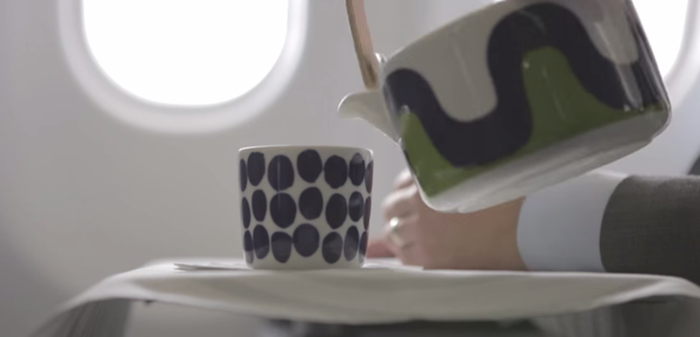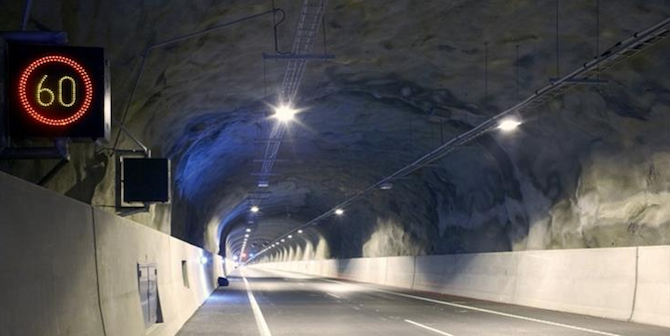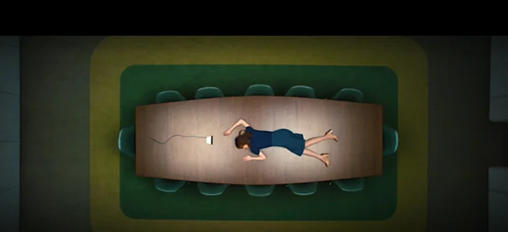
February 11, 2015
Dispatch from Helsinki

An example of Marimekko’s collaboration with FinnAir in-flight service | photo: FinnAir

The Helsinki Artek store in 1955 | photo: Artek Open Archives
Driving toward a factory in Kotka—more on this next time—our naval-architect guide reminded us that the road we were on led to Saint Petersburg, traveled by the Czar’s army on its way to capture Helsinki from the Swedes. Finland has only been its own country since 1917, but was most valuable to its occupiers as a buffer and its small population of foresters and fishermen were pretty much left alone. Swedish was the official language until, in the nineteenth century, Finns campaigned to modernize their own ancient non-Indo-European language. Our guide referred to his country as a little brother, culturally aligned, but fiercely competitive with big brother Sweden.

A tunnel along the E18 Koskenkylä-Kotka motorway | courtesy Skanska
Just as international modernist movements were blowing across its borders Finland was developing its image as an independent nation. From this fertile situation designers, writes Korvenmaa, evolved “the successful tactics of a cultural periphery in which it utilized the ideas of major centres that created style while avoiding provincial plagiarism.” Finnish designers won a disproportionate number of awards from world’s fairs in Paris, Milan, and Barcelona, which led to a “feedback loop” of local interest: investment and then increased international success through the 1960s. Eventually Finnish designs were exported as exemplars of modern living in stores like Design Research in the US.

The Finnish design exhibition inside Alvar Aalto’s pavilion for the 1937 Paris World’s Fair | photo: Alvar Aalto Museum
Toward the end of the exhibit, less sexy ergonomic kneeling chairs and enormous mobile phones developed by Nokia are a reminder that Finnish designers continue to produce influential responses to everyday living. Skimming the surface of this fascinating design history it occurred to me that the seemingly conflicting impressions I had on the flight over and on the road—the significance of design in the country on the one hand, and the intensely sparse fringe location on the other—were actually part of a single phenomenon: the success and influence of Finnish designers was due, paradoxically, to their “outsider” status.

Nokia exhibit at Design Museum Helsinki | photo: Juliette Spertus
Homepage image: Alvar Aalto’s House of Culture, 1958 | photo by Juliette Spertus
Observed
View all
Observed
By Juliette Spertus
Related Posts

Civic Life
Ellen McGirt|Audio
DB|BD Season 12 Premiere: Designing for the Unknown – The Future of Cities is Climate Adaptive with Michael Eliason

Arts + Culture
Alexis Haut|Cinema
About face: ‘A Different Man’ makeup artist Mike Marino on transforming pretty boys and surfacing dualities

Design As
Lee Moreau|Audio
Designing for the Future: A Conversation with Don Norman (Design As Finale)

Arts + Culture
Alexis Haut|Analysis
Innies see red, Innies wear blue: Severance’s use of color to seed self-discovery
Recent Posts
DB|BD Season 12 Premiere: Designing for the Unknown – The Future of Cities is Climate Adaptive with Michael Eliason About face: ‘A Different Man’ makeup artist Mike Marino on transforming pretty boys and surfacing dualities Designing for the Future: A Conversation with Don Norman (Design As Finale) Innies see red, Innies wear blue: Severance’s use of color to seed self-discoveryRelated Posts

Civic Life
Ellen McGirt|Audio
DB|BD Season 12 Premiere: Designing for the Unknown – The Future of Cities is Climate Adaptive with Michael Eliason

Arts + Culture
Alexis Haut|Cinema
About face: ‘A Different Man’ makeup artist Mike Marino on transforming pretty boys and surfacing dualities

Design As
Lee Moreau|Audio
Designing for the Future: A Conversation with Don Norman (Design As Finale)

Arts + Culture
Alexis Haut|Analysis
